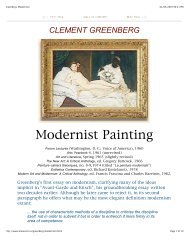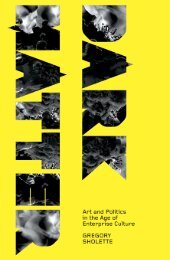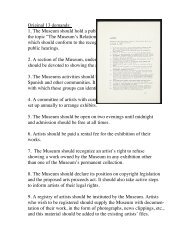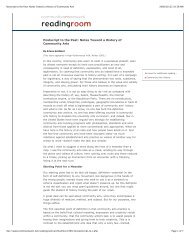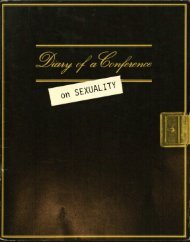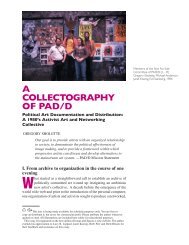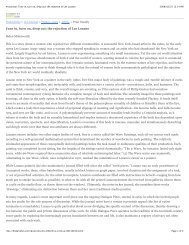Screen - Dark Matter Archives
Screen - Dark Matter Archives
Screen - Dark Matter Archives
Create successful ePaper yourself
Turn your PDF publications into a flip-book with our unique Google optimized e-Paper software.
56 photographs are deployed so that we need not look at them forWe rarely see a photograph in use which is not accompanied by57long, and so that, almost invariably, another photograph is alwaysalreadywriting: in newspapers the image is in most cases subordinate toin position to receive the displaced look.the text; in advertising. and illustrated magazines, there tends toThe awkwardness which accompanies the ove r~long contemplabe a more or less equal distribution of text and images; in art[jon of a photograph arises from a consciousness of the monocularand amateur photography the image predominates, although aperspective system of photography as a systematic deception. Thecaption or title is generally added. But the influence of languagelens arranges all information according to the laws of projectiongoes beyond the fact of the physical presence of writing as awhich place the subject as geometric point of origin of thedelibera te addition to the image, Even the uDcaptioned photograph,scene in an imaginary relationship with real space. but factsframed and isolated on a gaUery wall, is invaded by lanintrude to deconstruct the initial response : the eye/I cannot moveguage when it is looked at; in memory. in association, snatches ofwithin the depicted scene (w hich offers itself in the imaginary towords. and images continually intermingle and exchange one forprecisely such movement). it can only move across it to the pointthe other; what significant elements the subject recognises 'in' thewhere it encounters the fram e, however the subject's inevitablephotograph are inescapably supplemented from elsewhere.recognition of the rule of the frame may be postponed by a variety16 lndoed, all ofthose attributes of(he still imagewe rend to id entifyas 'aesthetic' maybe brought withinthe purview ofsuture,17 C Men. 'NotesTowards a Phenomenologyof theNarrative', in FilmLa nguage, OxfordUniversity Press.New York, 1974,p ZOoof strategies - prominent amongst which are 'compositional'devices for moving the eye from the framing edge. 'Good' compositionis probably no more or less tha n a set of devices forprolonging our imaginary command of the point·of-view. our self·assertion : a device for rerarding recognition of the autonomy ofthe frame. and the authority of the other it signifies. Compositiontherefore is also to be seen as a means of suturing. a means ofprolonging 'the imaginary fmce, the real power to please. of thephotograph ; it may be in this that it has survived so long, withina variety of rationalisations, as a criterion of value in visual artsgenerally, It)The subject's recognition of the absent other causes a 'tear' inits imaginary relationship with the visual fie ld. In the cinema suchde vices as the reverse-shot close up this rent in the imaginary.The still has no reverse-shot (\ am of course talking about thesingle image) but it does have, as \ have observed, forms ofidentification, fetishistic fascination, multiplication/repetition, and'good composition', all of whkh exert suturing effects, In addition,and most im portantly, it has the ever-present caption, and otherforms of linguistic expression which traverse, surround. and sup·I?0rt the image, Unpleasure is thus further averted by recourse towriting, which reinvests the subject with an authority strippedfro m it by the absent other; for whereas as Metz has observed'one of the characteristics of the world is that it is uttered by noone',n thete is never any question but that the verbal addressemanates from a subject and for a subject, ir recognises the su b·ject. As alienation intrudes to evacuate the subject from the visualregister the subjeC[ can 'take place' again in the caption, andwhen it expires there it can find itself returned again to the image(what other purpose is served by those texts - short, pathetiC which imfaria bly accompany 'pin-up' photographs in newspapetsand magazines?)IIIIn a famiHar cinematic convention, subjective consciousnessreflection, introspection, memory - is rendered as a disem·bodied 'voice-over' accompo nyi ng an otherwise silent image-track.I am not suggesting that such an interior monologue similarlyaccompanies our looking at photographs, nor do J wjsh to cJaimthat in the process of looking at a photograph we mentaUy translatethe image in terms of a redundant \'erbal description, What I'have in mind' is better expressed in the image of transparentcoloured inks which have been poured onto the surface of \vaterin a glass container: as tbe inks spread and sink their boundariesand relations are in constant alternation, and areas which at onemoment are distinct from one another may, at the next, overlap,interpenetrate. Analogies are of course only analogies, I simplywish to stress the fluidity of the phenomenon by contrast with theunavoidable rigidity of some of the schematic descriptions whichwill fo llow_It is conventionally held that photography is a 'visual medium'(the contenders in the 19205 Soviet photography debate neverdoubted it). At a stricti), physiological level it is quite straightforwardwhat we mean by 'the visual': it is that aspect of our experiencewhich results from light being reflected from objects intoour eyes. \Ve do not however s,e Our retinal ' images: as is wellknown,although we see the world as right-way-up the image onour retina is im'erted: \'w'e have two slightly discrepant retinalimages, but see only one image; we make mental allm\'ances forrhe known relative sizes of objects which override the actual r e-Iativesizes of their images on our retina ; we also make allowancesfor perspectival effects such as foreshortening, tbe foundation ofthe erroneous popular judgment that such effects in photographyare 'distortions'; our eyes operate in scanning movements, and the



